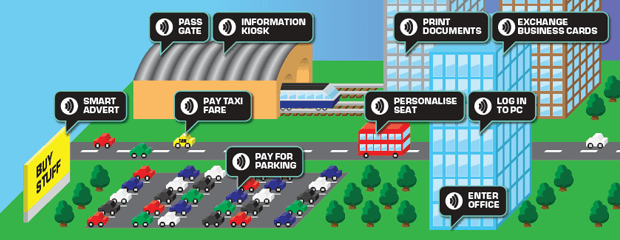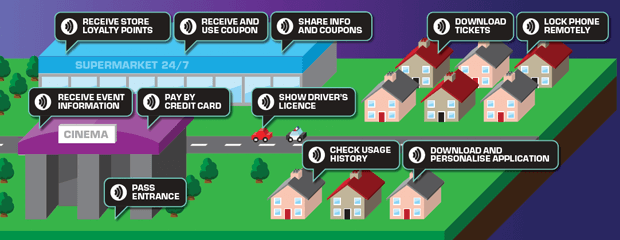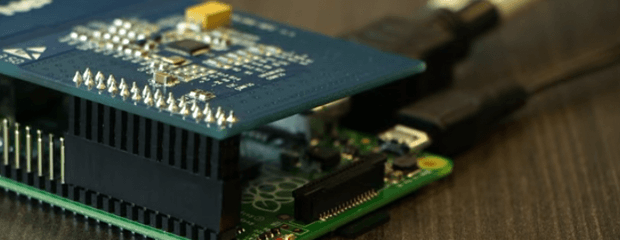Near Field Communication
NFC is a relatively new technology which is already quite commonplace. You may already be using it without realizing!
Many bank cards already have nfc tags built in to enable contactless payments but they are not alone, anything from your work pass to your mobile phone may already be NFC enabled but what is NFC?
NFC or near field communication, a subset of RFID, enables wireless radio communication between devices. It has an extremely short range, typically between 4-10cm depending on the size of the antenna and the environment it is used in. The development of NFC has been targeted towards simplifying a variety of electronic device interactions in a secure manner.

MODES & STANDARDS
NFC is standardized by the NFC forum and as such has particular specifications. The specification uses a transfer rate of 13.56 MHz and supports data rates of up to 424kbps. This speed is not very useful for applications such as media streaming however it can be used to quickly and easily setup a connection using an alternative technology such as Wi-Fi or Bluetooth. NFC devices can communicate in one of two modes.
ACTIVE
In which the device has a power supply and can communicate with any other NFC compatible device.
PASSIVE
In which the device is inactive until an active device is brought within range. The active device will generate radio signals which then induce an electric current in the passive device giving it power. The passive device can then modulate the electromagnetic field to respond to the active device.
CARD EMULATION MODE
Card emulation mode allows active NFC devices to emulate a passive NFC smart card or tag. In this mode the NFC device can be used to perform functions such as contactless purchasing and access to controlled areas. | PEER-TO-PEER MODE
Peer-to-peer mode allows two NFC devices to exchange data in both directions. This can allow the devices to talk to each other and share information such as virtual business cards, Wi-Fi and Bluetooth setup data or digital photos. | READER/WRITER MODE
Reader/Writer mode allows active NFC devices to interact with inexpensive NFC smart cards and embedded tags. The reader can be used to download a timetable or view a special offer from a smart poster. |
Major Applications
Because NFC technology is so versatile the potential applications are almost unending. Here are some of the current major applications for NFC technology.
1. CONTACTLESS PAYMENT
The most commonly perceived application for NFC technology, contactless payment is already in widespread use in bank cards utilizing RFID to allow low value transactions to take place quickly and easily. NFC is an improvement to RFID in this capacity as the shorter communication distance gives greater security. NFC is also widely available in smart phones which can allow software to take advantage of the more complex interactions offered by the NFC standard. This can include functions such as updating a customers loyalty point balance during a transaction.
2. SMART POSTERS
Another interesting application of NFC technology is the use of smart posters. These have tiny embedded NFC tags which can be used to direct users to rich media content or to provide information such as timetables. This functions similarly to QR Codes however NFC is much quicker as it does not require the scanning and processing of a QR Code.
3. BOOTSTRAPPING BLUETOOTH/WI-FI
While NFC technology is not suited to the transfer of large amounts of data it is however already used in devices such as smartphones and routers to initialize and configure connections for more appropriate technologies such as Wi-Fi and Bluetooth.
4. SOCIAL
NFC technology can also be utilized for quick and easy sharing of contact information and personal documents. This is a great improvement over the standard digital method which requires the two parties to first swap some form of contact details such as E-mail addresses or phone numbers.
5. IDENTITY
Other forms of RFID are already in widespread use in biometric passport documentation. Depending on the reader used this can have quite a long range and while some of these documents are shielded to prevent unauthorised reading, not all are. NFC technology could greatly decrease the privacy risk by only allowing these documents to be accessed from within a very short distance.
6. ACCESS
Electronically operated locks similar to those used in hotels would benefit greatly from NFC. This would allow inexpensive NFC tags to be mailed to customers prior to arrival which are then enabled/disabled at the relevant times by a control centre. As an alternative the card emulation communication mode coupled with a downloadable application would allow a smartphone to respond to an NFC device mounted by a door.
7. SMARTPHONE AUTOMATION
NFC tags can be used alongside smartphones to automate many aspects of everyday life. An NFC tag just inside your front door could be used to turn on your PC or laptop or allow visitors to connect to your Wi-Fi without divulging the password, while an NFC tag in your car could enable Bluetooth to connect to the hands free kit or start a navigation application.

SOME OTHER CURRENT PROJECTS USING NFC TAGS…
NFC-RINGAn NFC tag embedded into a piece of jewellery. Contains two separate tags and has a max range of 1mm for privacy, both tags will crosstalk if scanned at range which makes unintentional access almost impossible. | ROSETTA STONE MICROCHIPAn NFC enabled gravestone allowing users to tap a potentially tiny “desktop” monument to receive a wealth of information about the deceased. | WEARABLE HEALTH SENSORSNFC enabled disposable health sensors that enable discharged patients to self monitor their conditions and send the data to health professionals via SMS or E-Mail. |
An Introduction to NXP Explore NFC
Near Field Communication for your Raspberry Pi
- Full NFC compliant expansion board
- Three 3 NFC modes: Reader, P2P and Card Emulation
- Flexible interface via SPI or I²C
- Integrated high performance antenna
- Complete with MIFARE Ultralight RFID card

What can NFC do for you?
One of the major benefits of NFC technology is its security. The extremely short range makes it inherently difficult for transmissions to be intercepted or modified covertly or indeed for devices to communicate unintentionally, in addition developers are able to build encryption such as SSL into their applications to further protect communication.
NFC is an interesting technology still in relative infancy but with a lot of potential, it will be interesting to see what other innovative uses are contrived for it and whether consumer engagement will be strong enough to push the technology in new and unanticipated directions.
The Convenience Offered by NFC is substantial. Not only is it simple to use but it could replace a whole host of items such as bank cards, house keys, work passes, passports, car keys, train tickets & parking tickets. NFC, unlike its parent technology RFID; allows for 2 way communication enabling more complicated interactions. You could, for example add loyalty points to a customer’s “digital wallet” while simultaneously accepting payment from the same device or receive a train timetable while paying for a ticket. NFC tags themselves, have the potential to become ubiquitous.
They are tiny, inexpensive, do not require their own power source and if installed in a suitable environment require no maintenance. As such they could be placed almost anywhere. In posters or other advertising NFC tags can provide content (or links to content) instantly, this is an improvement on other technologies such as QR or barcode reading where the user needs to scan an image which may fail in low light situations.
Download our Tech Journal on NFC technology here.